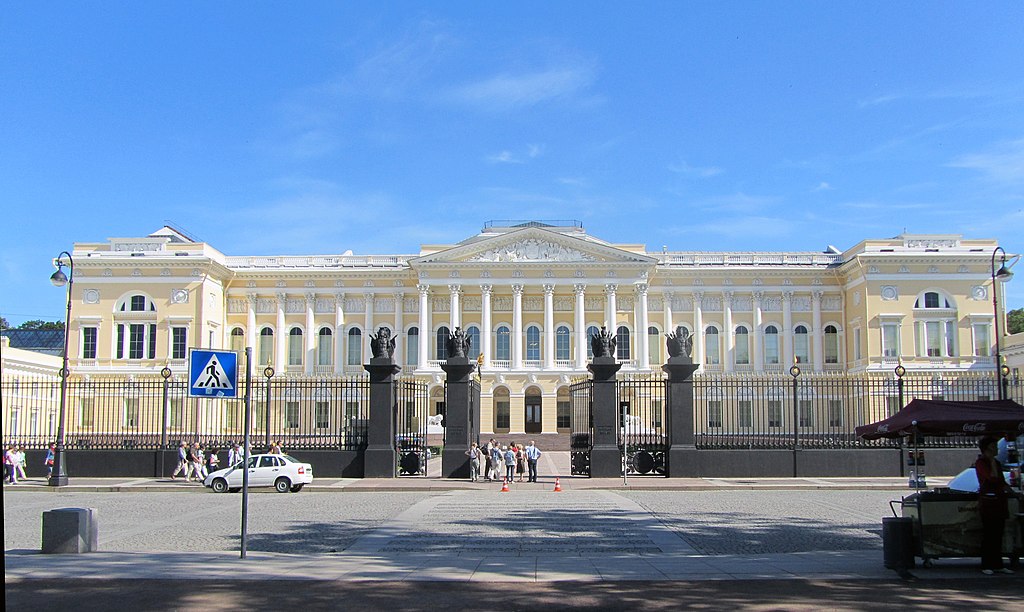The State Russian Museum, formerly the Russian Museum of His Imperial Majesty Alexander III, located on Arts Square in Saint Petersburg, is the world’s largest depository of Russian fine art. It is also one of the largest museums in the country.
The museum was established in 1895, and its original collection was composed of artworks taken from the Hermitage Museum, Alexander Palace, and the Imperial Academy of Arts. After the Russian Revolution of 1917, many private collections were nationalized and relocated to the Russian Museum.
Today the collection shows Russian art beginning in the 12th century up to socialist realism and in the USSR to the 20th century.
A Virtual Tour of the Russian Museum
- “Portrait of Anna Akhmatova” by Nathan Altman
- “The Last Day of Pompeii” by Karl Bryullov
- “Reply of the Zaporozhian Cossacks” by Ilya Repin
- “The Ninth Wave” by Ivan Aivazovsky
Highlights of the Russian Museum
- “Portrait of Anna Akhmatova” by Nathan Altman
- “Portrait of Anna Akhmatova” by Nathan Altman was inspired by the poet, who was one of the most significant Russian poets of the 20th century. She was shortlisted for the Nobel Prize in 1965 and received second-most nominations for the award the following year. Altman first met Akhmatova in Paris in 1911 and again during their meetings at the Stray Dog cabaret in St Petersburg. This portrait is one of Nathan Altman’s most famous works and depicts Akhmatova as many contemporaries remembered her. She was a melancholy woman, tall and slim, with a sharp profile and a fringe. Altman shows the poet against a landscape of shining crystals, symbolizing her world of sublime and abstract dreams. The composition was conceived in Cubist style and painted in 1914 in Leningrad (now Saint Petersburg).
- “The Last Day of Pompeii” by Karl Bryullov
- “The Last Day of Pompeii” by Karl Bryullov depicts the volcanic ash and pumice from the eruption of Mount Vesuvius in AD 79 that inundating inhabitants. Those who did not escape the lethal effects of the earthquake and explosive eruption were buried in over 4 m (13 ft) of volcanic ash. Pompeii was an ancient Roman city near modern Naples. The Roman town of Pompeii, along with Herculaneum and many villas in the surrounding area, were buried in volcanic ash. Briullov visited the partially excavated Pompeii in 1828 and made sketches depicting “The Last Day of Pompeii.”
- “Reply of the Zaporozhian Cossacks” by Ilya Repin
- “Reply of the Zaporozhian Cossacks” by Ilya Repin depicts a scene set in 1676, based on the legend of Cossacks sending a reply to an ultimatum of the Sultan of the Ottoman Empire, Mehmed IV. The initial response has not survived; however, in the 1870s, an amateur ethnographer found a copy made in the 18th century. He gave it to a historian, who, by chance, read it to his guests, among whom was the painter Ilya Repin. Repin became fascinated by the story and, in 1880, started the first of his studies on the subject.According to the story, the Zaporozhian Cossacks, who were inhabiting the lands around the lower Dnieper River in Ukraine, had defeated the Ottoman Empire forces in battle. However, Mehmed demanded that the Cossacks submit to Ottoman rule. The Cossacks, led by Ivan Sirko, replied in a stream of invective and vulgar rhymes. They wrote a letter, replete with insults and profanities. The painting exhibits the Cossacks’ pleasure at striving to come up with ever more vulgarities.
- “The Ninth Wave” by Ivan Aivazovsky
- “The Ninth Wave” by Ivan Aivazovsky depicts a sea after a night storm and the people facing death attempting to save themselves by clinging to debris from a wrecked ship. The raft, in the shape of the cross, appears to be a Christian metaphor for salvation. The painting’s warm tones symbolize the opportunity for the people on the raft to survive. The title refers to an old sailing expression referring to a wave of an incredible size that comes after a succession of incrementally more massive waves. Aivazovsky’s painting shows both the destructiveness and beauty of nature.
Russian Museum
- Name: Russian Museum
- Russian: Государственный Русский музей
- City: Saint Petersburg
- Country: Russia
- Type: Art and Culture Museum
- Established: 1895
- Location: Inzhenernaya St, 4, Sankt-Peterburg, Russia
A Virtual Tour of Museums in Russia
Museums in Russia
- Moscow:
- Pushkin Museum
- Saint Petersburg:
- Hermitage Museum
- State Russian Museum
Map for State Russian Museum
St. Petersburg Guide – Russian Museum
The State Russian Museum
~~~
“There is no subject so old that something new cannot be said about it.”
– Fyodor Dostoevsky
~~~
Photo Credit: MarisaLR [CC BY-SA 3.0 es (https://creativecommons.org/licenses/by-sa/3.0/es/deed.en)]
Top Posts & Pages








 Sponsor your Favorite Page
Sponsor your Favorite Page SEARCH Search for: Search Follow UsJoin – The JOM Membership Program
Become a Patron!
Sponsor a Masterpiece with YOUR NAME CHOICE for $5
Share this:
- Tweet

